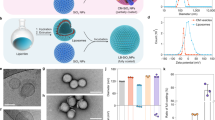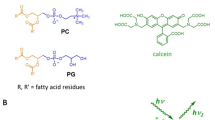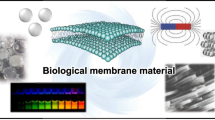Abstract
Phospholipids in the cell membranes of all eukaryotic cells contain phosphatidyl choline (PC) as the headgroup. Here we show that hyperbranched polyglycerols (HPGs) decorated with the ’PC-inverse’ choline phosphate (CP) in a polyvalent fashion can electrostatically bind to a variety of cell membranes and to PC-containing liposomes, the binding strength depending on the number density of CP groups per macromolecule. We also show that HPG–CPs can cause cells to adhere with varying affinity to other cells, and that binding can be reversed by subsequent exposure to low molecular weight HPGs carrying small numbers of PCs. Moreover, PC-rich membranes adsorb and rapidly internalize fluorescent HPG–CP but not HPG–PC molecules, which suggests that HPG–CPs could be used as drug-delivery agents. CP-decorated polymers should find broad use, for instance as tissue sealants and in the self-assembly of lipid nanostructures.
This is a preview of subscription content, access via your institution
Access options
Subscribe to this journal
Receive 12 print issues and online access
$259.00 per year
only $21.58 per issue
Buy this article
- Purchase on Springer Link
- Instant access to full article PDF
Prices may be subject to local taxes which are calculated during checkout




Similar content being viewed by others
References
Sohlenkamp, C., López-Lara, I. M. & Geiger, O. Biosynthesis of phosphatidylcholine in bacteria. Prog. Lipid Res. 42, 115–162 (2003).
Singer, S. J. & Nicolson, G. L. The fluid mosaic model of the structure of cell membranes. Science 175, 720–731 (1972).
Doherty, G. J. & McMahon, H. T. Mediation, modulation and consequences of membrane–cytoskeleton interactions. Annu. Rev. Biophys. 37, 65–95 (2008).
Burdge, G. C., Kelly, F. J. & Postle, A. D. Mechanisms of hepatic phosphatidylcholine synthesis in the developing guinea pig: Contributions of acyl remodelling and of N-methylation of phosphatidylethanolamine. Biochem. J. 290, 67–73 (1993).
Vance, D. E. & Ridgway, N. D. The methylation of phosphatidylethanolamine. Prog. Lipid Res. 27, 61–79 (1988).
Aktas, M. et al. Phosphatidylcholine biosynthesis and its significance in bacteria interacting with eukaryotic cells. Eur. J. Cell Biol. 89, 888–894 (2010).
Kent, C. Regulatory enzymes of phosphatidylcholine biosynthesis: A personal perspective. Biochim. Biophys. Acta 1733, 53–66 (2005).
Vance, D. E., Li, Z. & Jacobs, R. L. Hepatic phosphatidylethanolamine N-methyltransferase, unexpected roles in animal biochemistry and physiology. J. Biol. Chem. 282, 33237–33241 (2007).
Goldfine, H. Bacterial membranes and lipid packing theory. J. Lipid Res. 25, 1501–1507 (1984).
Peschel, A. et al. Staphylococcus aureus resistance to human defensins and evasion of neutrophil killing via the novel virulence factor Mprf is based on modification of membrane lipids with L-lysine. J. Exp. Med. 193, 1067–1076 (2001).
Hazen, S. L. & Chisolm, G. M. Oxidized phosphatidylcholines: Pattern recognition ligands for multiple pathways of the innate immune response. Proc. Natl Acad. Sci. USA 99, 12515–12517 (2002).
Rao, M., Eichberg, M. R. & Oró, J. Synthesis of phosphatidylcholine under possible primitive earth conditions. J. Mol. Evol. 18, 196–202 (1982).
Cundell, D. R., Gerard, N. P., Gerard, C., Idanpaan-Heikkila, I. & Tuomanen, E. I. Streptococcus pneumoniae anchor to activated human cells by the receptor for platelet-activating factor. Nature 377, 435–438 (1995).
Raetz, C. R. H. Molecular genetics of membrane phospholipid synthesis. Annu. Rev. Genet. 20, 253–295 (1986).
Van Der Sanden, M. H. M., Houweling, M., Van Golde, L. M. G. & Vaanderager, A. B. Inhibition of phosphatidyl choline synthesis induces expression of the endoplasmic reticulum stress and apoptosis-related protein CCAAT/enhancer-binding protein-homologous protein (CHOP/GADD153). Biochem. J. 369, 643–650 (2003).
Norris, V. & Raine, D. J. A fission–fusion origin for life. Orig. Life Evol. B 28, 523–537 (1998).
Ring, A., Weiser, J. N. & Tuomanen, E. I. Pneumococcal trafficking across the blood–brain barrier. Molecular analysis of a novel bidirectional pathway. J. Clin. Invest. 102, 347–360 (1998).
Prescott, S. M., Zimmerman, G. A. & McIntyre, T. M. Platelet-activating factor. J. Biol. Chem. 265, 17381–17384 (1990).
Prescott, S. M., McIntyre, T. M., Zimmerman, G. A. & Stafforini, D. M. Sol Sherry lecture in thrombosis molecular events in acute inflammation. Arterioscler. Thromb. Vasc. 22, 727–733 (2002).
Papp, I., Dernedde, J., Enders, S. & Haag, R. Modular synthesis of multivalent glycoarchitectures and their unique selectin binding behavior. Chem. Commun. 5851–5853 (2008).
Weinhart, M., Gröger, D., Enders, S., Dernedde, J. & Haag, R. Synthesis of dendritic polyglycerol anions and their efficiency toward L-selectin inhibition. Biomacromolecules 12, 2502–2511 (2011).
Calderon, M., Quadir, M. A., Sharma, S. K. & Haag, R. Dendritic polyglycerols for biomedical applications. Adv. Mater. 22, 190–218 (2010).
Wilms, D., Stiriba, S. E. & Frey, H. Hyperbranched polyglycerols: From the controlled synthesis of biocompatible polyether polyols to multipurpose applications. Acc. Chem. Res. 43, 129–141 (2010).
Kainthan, R. K., Janzen, J., Levin, E., Devine, D. V. & Brooks, D. E. Biocompatibility testing of branched and linear polyglycidol. Biomacromolecules 7, 703–709 (2006).
Kainthan, R. K., Hester, S. R., Levin, E., Devine, D. V. & Brooks, D. E. In vitro biological evaluation of high molecular weight hyperbranched polyglycerols. Biomaterials 28, 4581–4590 (2007).
Kainthan, R. K. & Brooks, D. E. In vivo biological evaluation of high molecular weight hyperbranched polyglycerols. Biomaterials 28, 4779–4787 (2007).
Liu, Z., Janzen, J. & Brooks, D. E. Adsorption of amphiphilic hyperbranched polyglycerol derivatives onto human red blood cells. Biomaterials 31, 3364–3373 (2010).
Kainthan, R. K., Muliawan, E. B., Hatzikiriakos, S. G. & Brooks, D. E. Synthesis, characterization, and viscoelastic properties of high molecular weight hyperbranched polyglycerols. Macromolecules 39, 7708–7717 (2006).
Brooks, D. E. in Blood Cells, Rheology and Aging (ed. Platt, D.) 158–162 (Springer, 1988).
Neu, B. & Meiselman, H. J. Depletion-mediated red blood cell aggregation in polymer solutions. Biophys. J. 83, 2482–2490 (2002).
Boynard, M. & Leliere, J. C. Size determination of red blood cell aggregates induced by dextran using ultrasound backscattering phenomenon. Biorheology 27, 39–46 (1990).
Chien, S. & Lang, L. A. Physicochemical basis and clinical implications of red cell aggregation. Clin. Hemorheol. Microcirc. 7, 71–91 (1987).
Nash, G. B., Wenby, R. B., Sowemimo-Coker, S. O. & Meiselman, H. J. Influence of cellular properties on red cell aggregation. Clin. Hemorheol. Microcirc. 7, 93–108 (1987).
Jackson, S. N. et al. Direct tissue analysis of phospholipids in rat brain using MALDI-TOFMS and MALDI-Ion Mobility-TOFMS. J. Am. Soc. Mass Spectrom. 16, 100–138 (2005).
Kawaguchi, M. & Takahashi, A. Polymer adsorption at solid–liquid interfaces. Adv. Colloid Interface Sci. 37, 219–317 (1992).
Szleifer, I. Protein adsorption on surfaces with grafted polymers: A theoretical approach. Biophys. J. 72, 595–612 (1997).
Brooks, D. E., Haynes, C. A., Hritcu, D., Steels, B. M. & Müller, W. Size exclusion chromatography does not require pores. Proc. Natl Acad. Sci. USA 97, 7064–7067 (2000).
Brooks, D. E., Greig, R. G. & Janzen, J. Mechanisms of Erythrocyte Aggregation: Erythrocyte Mechanisms and Blood Flow Ch. 6 (Liss, 1980).
Sheng, Q., Schulten, K. & Pidgeon, C. Molecular dynamic simulation of immobilized artificial membranes. J. Phys. Chem. 99, 11018–11027 (1995).
Kainthan, R. K., Janzen, J., Kizhakkedathu, J. N., Devine, D. V. & Brooks, D. E. Hydrophobically derivatized hyperbranched polyglycerol as a human serum albumin substitute. Biomaterials 29, 1693–1704 (2008).
Kizhakkedathu, J. N. et al. High molecular weight polyglycerol-based multivalent mannose conjugates. Biomacromolecules 11, 2567–2575 (2010).
Connor, J., Pak, C. C. & Schroit, A. J. Exposure of phosphatidylserine in the outer leaflet of human red blood cells. J. Biol. Chem. 269, 2399–2404 (1994).
Yao, Z. M. & Vance, D. E. The active synthesis of phosphatidylcholine is required for very low density lipoprotein secretion from rat hepatocytes. J. Biol. Chem. 263, 2998–3004 (1988).
Robinson, B. S., Yao, Z. M., Baisted, D. J. & Vance, D. E. Lysophosphatidylcholine metabolism and lipoprotein secretion by cultured rat hepatocytes deficient in choline. Biochem. J. 260, 207–214 (1989).
Chien, S. Aggregation of red blood cells: An electrochemical and colloid chemical problem. Adv. Chem. 188, 3–38 (1980).
Dembitzer, H. M., Oberhardt, B. J., Duffy, J. L. & Lalezari, P. Polybrene-induced red blood cell aggregation in vitro morphological aspects. Transfusion 12, 94–97 (1972).
Van Oss, C. J. & Mohn, J. F. Scanning electron microscopy of red cell agglutination. Vox Sang. 19, 432 (1970).
Fine, M. et al. Massive endocytosis driven by lipidic forces originating in the outer plasmalemmal monolayer: A new approach to membrane recycling and lipid domains. J. Gen. Physiol. 137, 137–154 (2011).
Conner, S. D. & Schmid, S. L. Regulated portals of entry into the cell. Nature 422, 37–44 (2003).
Mugabe, C. et al. Paclitaxel incorporated in hydrophobically derivatized hyperbranched polyglycerols for intravesical bladder cancer therapy. Br. J. Urol. 103, 978–986 (2008).
Acknowledgements
Financial support from Canadian Institutes of Health Research (CIHR), Canadian Blood Services (CBS), Canada Foundation for Innovation (CFI), and Michael Smith Foundation for Health Research (MSFHR) are gratefully acknowledged. The authors thank the Laboratory of Molecular Biophysics Macromolecular Hub at the University of British Columbia (UBC) Center for Blood Research for the use of their research facilities. These facilities are supported in part by grants from the Canada Foundation for Innovation and the Michael Smith Foundation for Health Research. J.N.K. acknowledges the New Investigator award from CIHR and CBS, as well as the Career Investigator Scholar award from MSFHR. The authors acknowledge Derrick Horne (UBC Bioimaging Facility) for technical assistance.
Author information
Authors and Affiliations
Contributions
X.Y., J.N.K. and D.E.B. conceived, designed and co-wrote the paper. X.Y., Z.L., I.C., S.H., W.C. and R.K.K performed the experiments. J.J. helped to analyse the data. All authors discussed the results and commented on the manuscript.
Corresponding authors
Ethics declarations
Competing interests
The authors declare no competing financial interests.
Supplementary information
Supplementary Information
Supplementary Information (PDF 2863 kb)
Rights and permissions
About this article
Cite this article
Yu, X., Liu, Z., Janzen, J. et al. Polyvalent choline phosphate as a universal biomembrane adhesive. Nature Mater 11, 468–476 (2012). https://doi.org/10.1038/nmat3272
Received:
Accepted:
Published:
Issue Date:
DOI: https://doi.org/10.1038/nmat3272
This article is cited by
-
Enhanced tumour penetration and prolonged circulation in blood of polyzwitterion–drug conjugates with cell-membrane affinity
Nature Biomedical Engineering (2021)
-
Polysaccharide-based hemostats: recent developments, challenges, and future perspectives
Cellulose (2021)
-
Regulation of the cellular uptake of nanoparticles by the orientation of helical polypeptides
Nano Research (2019)
-
pH-responsive polymersome based on PMCP-b-PDPA as a drug delivery system to enhance cellular internalization and intracellular drug release
Chinese Journal of Polymer Science (2017)
-
A comparison of the cationic ring-opening polymerizations of 3-oxetanol and glycidol
Macromolecular Research (2013)



